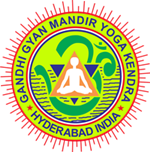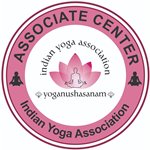- I. Introduction
- II. Advantages of Pranayaam
- III. Precautions to be observed
- IV. Different Methods of Pranayaam
- 1. Nadi Shodhan Pranayaam
- 2. Bhastrika Pranayaam
- – a. Chandrang Bhastrika
- – b. Suryang Bhasthrik
- – c. Sushumna Bhastrika
- – d. Chandrang Suryang Bhastrika
- 3. Bhramari Pranayaam
- 4. Sheetali Pranayaam
- 5. Seetakari Pranayaam
- 6. Surya-bhedi Pranayaam
- 7. Chandra-bhedi Pranayaam
- 8. Ujjayi Pranayaam
- 9. Kapal-bhati Shuddhi Pranayaam
I.Introduction:
Pran + Ayaam = Pranayaam. ‘Pran’ means breath or respiration or universal energy or power or life. ‘Ayaam’ means extension or expansion. Therefore Pranayaam means extension of the breath or life span.
According to the ‘Yogasutra’ of Maharshi Patanjali, acquiring the skill of controlling and regulating the inspiration (inhaling of the breath), the expiration (exhaling of the breath) and retention of breath is called ‘Pranayaam’. Some call it as Vayu Sadhana also.
‘Life’ exists in the nervous system, the blood circulatory system, heart, lungs, digestive system, excretory organs etc. Pranayaam strengthens, protects and energizes them. There is a saying in this context in Sanskrit that “Pranayaamena Yuktena, Sarva Roga Kshaya Bhaveth”. If Pranayaam is practiced systematically and regularly, all the diseases can be avoided, prevented and controlled. However, improper practice may cause problems.
There are five kinds of breath. They are Praan, Apaan, Samaan, Udaan and Vyaan.
Name Place of Existence Benefactors
Praan Heart Respiration & speech
Apaan Below the navel Excretion – Kidneys, anus & genitals
Samaan Between heart Digestion – Liver, & navel stomach, pancreas
Udaan Throat Eyes, nose, ears, arms
Vyaan Whole body All the activities of the body
Components of Pranayaam:
Breathing out is called “Rechak” and breathing in is called “Purak”. Holding the breath in is called “Antar Kumbhak”. Breathing out and holding it outside is called “Bahya Kumbhak”. These four are the components of Pranayaam.
According to the modern physicians the function of both the nostrils is one and the same. But Yogis have found the difference between the functioning of the two nostrils. According to their research findings, the breath that moves through the right nostril is a bit warm. Therefore they called the breath passing through right nostril as “Surya Nadi” or “Surya Swar”. Similarly the breath that moves through the left nostril is a bit cool, so it is called ‘Chandra Nadi’ or ‘Chandra Swar’. Importance has been given to co-ordinate these two in Yogashastra. ‘Ha’ is denoted as ‘Chandra’ and ‘Tha’ is denoted as ‘Surya’. As a result of this co-ordination ‘Hath Yog’ has been evolved. ‘Hath Yog’ is the science related to Chandra and Surya Nadis. Entire science of Pranayaam deals with Chandra-Surya swars.
II. Advantages of Pranayaam:
1. Lungs function very well.
2. Body gets sufficient oxygen and so becomes healthy.
3. Blood is purified and richly oxygenated.
4. Heart is energized.
5. The mind is alert and acts spontaneously.
6. Intestines, veins and nerves are cleaned.
7. Appetite is increased.
8. The mind is kept away from ill will. Thoughts become pure and positive.
9. It acts like a gateway to higher Yoga and leads to realize the Self.
10. The life span is extended. This is the special feature of Pranayaam.
III. Precautions to be observed:
1. Pranayaam should be practiced either in an open ground, or in a garden, or in a well-ventilated room, sitting on either a carpet or a blanket or a clean cloth or a chair.
2. It should not be practiced in fiercely blowing winds.
3. It should not be practiced in a dirty or foul smelling or a smoky place and also where there is either the cigarette or beedi or cigar smoking smells. Also the practitioner should give up smoking habits for better results.
4. It should not be practiced with a full stomach.
5. It should be practiced in minimum or loose clothes.
6. Other Yogasans may be practiced before or after Pranayaam. But in any case Shanti asan is to be practiced at the beginning and also end to rest and relax.
7. The most convenient asanas to practice Pranayaam are Sukhasan, Vajrsan, Padmasan, or Siddhasan. Those who cannot sit on the floor may do so sitting straight in a chair. Under unavoidable physical conditions, this may be practiced even in lying posture (without using pillow).
8. Waist, back, backbone and neck should be in a straight position while practicing Pranayaam. Head should not be bent.
9. During the practice of Pranayaam, the right nostril is to be closed by the right thumb and the left nostril with the right ring finger.
10. When the nostrils are blocked, they should be first cleaned by doing Jalaneti or Sutraneti Kriyas and then Pranayaam is taken up. If it is done so, the breathing is quite easy during Pranayaam.
11. The mind should be concentrated on the breathing alone.
12. Practice should be rhythmic i.e. each breath should be similar to other. The rhythm plays a big role in achieving the best results of Pranayaam.
13. After learning from experts, eyes should be kept closed at the time of practice, for better concentration.
14. Refer other general rules as in chapter 5.
IV. Different Methods of Pranayaam:
Since birth till death, the breath is an automatic continuous process. If this automatic process is carefully noticed it is called Breath Awareness. If the breath with this awareness is streamlined in a systematic and scientific way, it is called Pranayaam in Yogic terms. Every Yogasan is blended with Pranayaam.
Pranayaam has been classified into 108 types, with different permutations and combinations of all the components of breath viz. Rechak – Purak – Kumbhak and the two Chandra and Surya swars. Among them the following have been identified as most important. They are:
Nadi Shodhan , Bhastrika, Bhramari, Sheetali, Seetkari, Suryabhedi, Chandrabhedi, Ujjayi, Kapal-Bhati.
1. Nadi Shodhan Pranayaam:
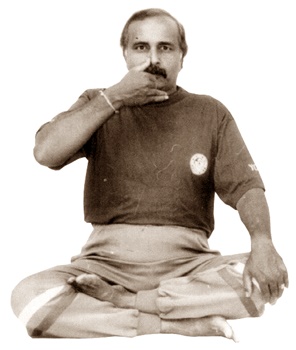
This is also known as Saral Pranayaam or Anulom-Vilom Pranayaam.
Procedure:
Sitting erect, eyes are closed. The concentration is focused on the point between the eye brows for some time. Then the right nostril is closed with the right thumb and the complete inner air is breathd out through the left nostril slowly. Then the air is breathd in through the left nostril. Then right nostril is opened and the left nostril is closed with the right hand ring finger, the inside air is completely breathd out through the right nostril and again breathd in through the right nostril only. Now one round of Pranayaam is completed. In the initial stage three such rounds are practiced, later the number of rounds is increased gradually upto comfortable and available time, which can be around 10 to 15 minutes per day.
At the beginning (a) Rechak (breathing out) and (b) Purak (breathing in) are practiced for some days. After getting Rechak and Purak as a comfortable habit the (c) Antar Kumbhak (holding the breath in) is practiced. After acquiring perfection in a, b and c above (d) Bahya Kumbhak (holding the breath out) is also taken up. Regular practice as above helps in getting the skill of controlling the breath. Later after 3 to 4 months of constant practice, the components of Nadi Shodhan Pranayaam may be scheduled as follows:
Rechak – 10 seconds
Bahya Kumbhak – 5 seconds
Purak – 5 seconds
Antar Kumbhak – 20 seconds
They should be practiced by watching the time carefully.
The above schedule tells us the ratio of 2:1:1:4. When the practitioner get the habit of the above schedule, he may gradually increase the time in the same ratio upto 60 seconds for Rechak, 30 seconds for Bahya Kumbhak, 30 seconds for Purak and 120 seconds for Antar Kumbhak. It may take about one year of serious practice to reach this level.
Awareness:
The breath
Advantages:
This pranayaam cures cold, cough and headache. There will not be any tension. The mind gets peace and tranquility. Sense organs, nerves and all the systems in the body are cleaned. Regular practice helps to slow down the normal breathing rate, resulting in elongating the life span.
2. Bhastrika Pranayaam:
Bhastrika means the bellow of the furnace. The bellow provides air to the furnace. In this Pranayaam process, breathing through the nose sounds like the bellow of the furnace.
There are four kinds of Bhastrika Pranayaam. They are:
a. Chandrang
b. Suryang
c. Sushumna
d. Chandrang – Suryang
a. Chandrang Bhastrika:
This can be practiced either standing or sitting erect. The right nostril is closed with the right thumb. From the left nostril the air is breathd out with great force, speed and sound. Immediately with the same force it is breathd in. This should be continuously exercised for 10 times or any more number of times to the possible extent. Navel should be sucked in during Rechak. Chest, navel and stomach should be bulged during Purak.
This Pranayaam should be intensively practiced by the people who have abnormal blood pressure and excess heat in the body. People suffering from Asthma should do it light.
b. Suryang Bhasthrik:
By closing the left nostril with right ring finger, the exercise is practiced with force as above.
People who have excess cold in the body and suffering from breathing trouble should practice this exercise intensively. People suffering from abnormal blood pressure and who have excess heat in the body should do it light.
c. Sushumna Bhastrika:
Closing the right nostril, the air is breathed out with force through the left nostril and again breathed in through the same nostril. Then the left nostril is closed and the air is breathed out with force through the right nostril and immediately breathed in through the same nostril. Quickly changing the nostril, the action is repeated in quick successions as long as it is possible. The chest and stomach are also sucked in and expanded consequently, as in (a).
The glands of liver, spleen, intestines, pancreas and kidneys are stimulated and energized with this Bhastrika.
d. Chandrang Suryang Bhastrika:
The air is completely breathed out through both the nostrils with force and the navel is sucked in towards backbone. Again it is breathed in through both the nostrils and the stomach is expanded to its maximum. The sound of breathing should resemble the sound of the furnace bellow. This is to be rhythematically practiced to the possible maximum number of times and rest should be taken thereafter.
Advantages:
It reduces excess fat from the body. Pot belly is gradually slimmed. Appetite increases. Phlegm is reduced and the heat in the body is increased. It purifies the lungs & blood and cures asthma. The efficiency of physical and mental work increases and thinking is sharpened.
Awareness:
The heat generated in the chest and stomach
Prohibition:
People suffering from heart disease, ulcer, giddiness and pregnants should not attempt the above kriyas.
Those who practice this Pranayaam should take milk, butter or ghee (melted butter).
3. Bhramari Pranayaam:
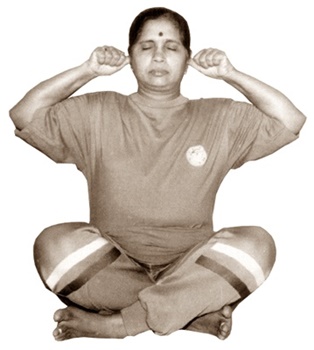
Bhramari means humming bee. In this Pranayaam the breathing sounds like humming of a bee.
Procedure:
The thumbs are placed in both the ears. Mouth is closed. Air is inhaled and withheld inside. Tongue is in normal position. The withheld air is slowly released through the nose creating a humming sound inside the nostrils. This is repeated about 20 times. Eyes are closed during this process.
Awareness:
The humming sound
Advantages:
This helps in streamlining the sound production process. The tone becomes melodious, delicate, smooth and rythemetic. This prevents and cures throat diseases. Tension is released and mind becomes fresh and rejuvenated.
Note: The meditator should come out of the trance through the humming sound of Bhramari.
The Omkar sound is also a Bhramari Pranayaam. The first cry of the born infant is the first Bhramari activity in the life.
4. Sheetali Pranayaam:
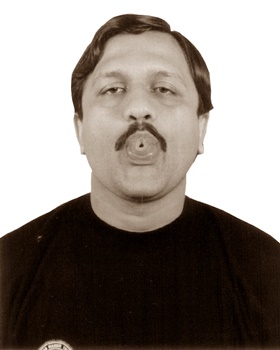
This Pranayaam cools down the body.
Procedure:
The tongue is stretched out and folded like a tube. The air is gradually sipped with a hissing sound through the folded tongue. The mouth is closed. The air is withheld inside for some time and released slowly through the nose. This is practiced three times at the beginning, later it is increased to 15 to 20 times.
Note: This should be intensively practiced in summer and less in winter.
Awareness:
Cooling effect in the throat
Advantages:
This is very useful for the people suffering from high blood pressure. The diseases of mouth, throat, tonsils and skin are prevented and controlled. The heat in the eyes is reduced. The entire body is cooled down. It quenches the thirst in the absence of water. Stress and tension reduce. Angry persons become peaceful.
5. Seetakari Pranayaam:
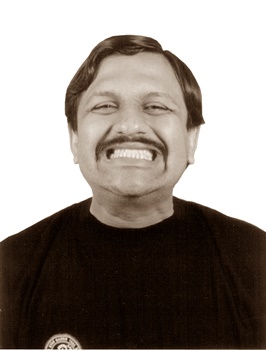
The hissing sound “s-s-s-s-s” is produced during this Pranayaam.
Procedure:
The upper and the lower teeth are pressed tight together and the tip of the tongue is made to touch the teeth ridge. The lips are opened wide and the air is sucked in through the tightly pressed teeth with the hissing sound, then the lips are closed. The inhaled air is withheld for some time inside, later it is released slowly through the nose. This is practiced three times at the beginning. It is later increased to 15 to 20 times.
Note: This should not be practiced in excess during winter. It may well be practiced in summer. People suffering from acute cold are advised not to attempt this.
Awareness:
The cool feeling inside mouth
Advantages:
All the advantages of Sheetali Pranayaam are there in this. It keeps the mouth clean and cool. It strengthens the teeth.
6. Surya-bhedi Pranayaam:
This generates energy in the form of heat in the body.
Procedure:
Every time, a deep breath is inhaled slowly through Suryanadi i.e. right nostril, and after withholding for some time it is exhaled through the Chandranadi i.e. left nostril.
Note: Heat is increased in the body through this activity. People of heat body and who suffer from acidity, fever, heart disease, high B.P. or epilepsy are advised not to attempt this.
Awareness:
The warm breath
Advantages:
It is highly beneficial for people suffering from low blood pressure. It cures cough, cold and asthma. Strength of the body is increased. Mind becomes alert. This helps in developing concentration before meditation.
7. Chandra-bhedi Pranayaam:
This keeps the body cool like the moon.
Procedure:
Every time, a deep breath is inhaled slowly through Chandra nadi i.e. left nostril. After withholding it for some time it is slowly exhaled through Suryanadi i.e. right nostril.
Note: People suffering from acute cold or asthma should not attempt this.
Awareness:
The cool breath
Advantages:
It keeps the body always cool. High blood pressure and the anger are reduced. Mind is always pleasant and full of joy.
8. Ujjayi Pranayaam:
It keeps the mind in subtle state.
Procedure:
A soft snoring sound is to be produced in the throat during the practice of this exercise. The head is bent a little low. The tongue is bent upwards and it touches the roof of the mouth (palate).
The air is inhaled slowly, through the nose, with a melodious sound created inside the throat, withheld inside for some time and exhaled through the nose with a soft snoring sound in the
throat.
In second variety, the exhalation is done through only left nostril, shutting the right one with right thumb.
Awareness:
The soft sound in the throat
Advantages:
It stimulates throat, lungs and heart. The diseases of ear, nose and throat are prevented. Cough, asthma, blood pressure are controlled. Anxiety, depression and negative thoughts are gradually eliminated. It is also practiced in Shanti asan to get a sound sleep, at bed time.
9. Kapal-bhati Shuddhi Pranayaam:
It purifies the entire skull including brain, eyes, ears, nose, throat and the central nervous system.
Procedure:
Every time breath is inhaled normally and exhaled with force creating a vigorous jerk inside the nostrils (as if sneezing out). With the jerk, abdomen moves in automatically everytime.
Advantages:
It improves memory, concentration, confidence and willpower, reduces fear, negetive thoughts and lethargy. Stomach problems are also solved.
![]()
Apart from the above, there are many other varieties of Pranayaam also.
The practitioners may learn under expert guidance and derive benefits by practicing the different Pranayaams with a peaceful mind and a whole heart according to their needs and convenience.
![]()
